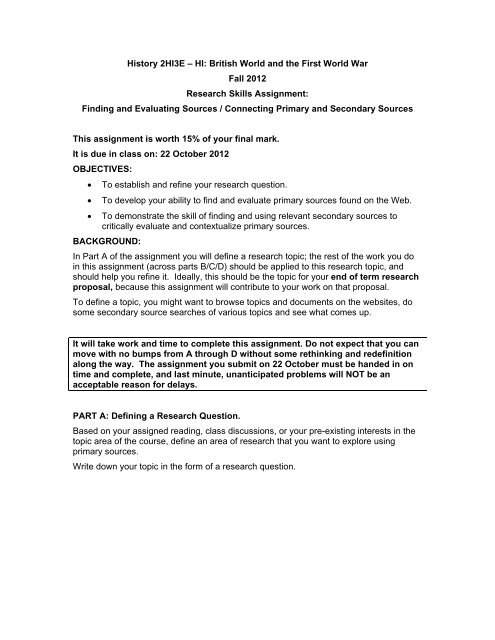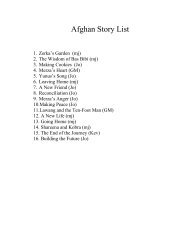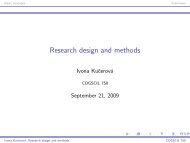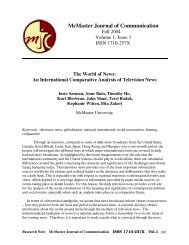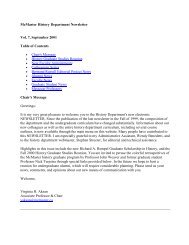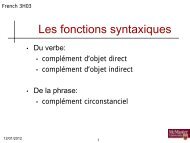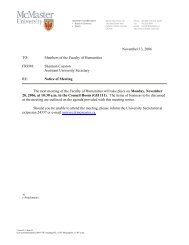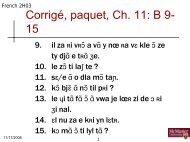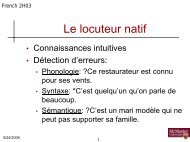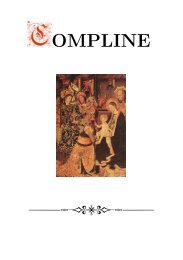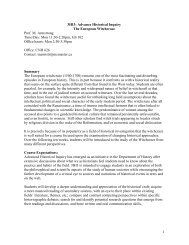Evaluating Primary Sources and Connecting them to Secondary
Evaluating Primary Sources and Connecting them to Secondary
Evaluating Primary Sources and Connecting them to Secondary
You also want an ePaper? Increase the reach of your titles
YUMPU automatically turns print PDFs into web optimized ePapers that Google loves.
His<strong>to</strong>ry 2HI3E – HI: British World <strong>and</strong> the First World War<br />
Fall 2012<br />
Research Skills Assignment:<br />
Finding <strong>and</strong> <strong>Evaluating</strong> <strong>Sources</strong> / <strong>Connecting</strong> <strong>Primary</strong> <strong>and</strong> <strong>Secondary</strong> <strong>Sources</strong><br />
This assignment is worth 15% of your final mark.<br />
It is due in class on: 22 Oc<strong>to</strong>ber 2012<br />
OBJECTIVES:<br />
• To establish <strong>and</strong> refine your research question.<br />
• To develop your ability <strong>to</strong> find <strong>and</strong> evaluate primary sources found on the Web.<br />
• To demonstrate the skill of finding <strong>and</strong> using relevant secondary sources <strong>to</strong><br />
critically evaluate <strong>and</strong> contextualize primary sources.<br />
BACKGROUND:<br />
In Part A of the assignment you will define a research <strong>to</strong>pic; the rest of the work you do<br />
in this assignment (across parts B/C/D) should be applied <strong>to</strong> this research <strong>to</strong>pic, <strong>and</strong><br />
should help you refine it. Ideally, this should be the <strong>to</strong>pic for your end of term research<br />
proposal, because this assignment will contribute <strong>to</strong> your work on that proposal.<br />
To define a <strong>to</strong>pic, you might want <strong>to</strong> browse <strong>to</strong>pics <strong>and</strong> documents on the websites, do<br />
some secondary source searches of various <strong>to</strong>pics <strong>and</strong> see what comes up.<br />
It will take work <strong>and</strong> time <strong>to</strong> complete this assignment. Do not expect that you can<br />
move with no bumps from A through D without some rethinking <strong>and</strong> redefinition<br />
along the way. The assignment you submit on 22 Oc<strong>to</strong>ber must be h<strong>and</strong>ed in on<br />
time <strong>and</strong> complete, <strong>and</strong> last minute, unanticipated problems will NOT be an<br />
acceptable reason for delays.<br />
PART A: Defining a Research Question.<br />
Based on your assigned reading, class discussions, or your pre-existing interests in the<br />
<strong>to</strong>pic area of the course, define an area of research that you want <strong>to</strong> explore using<br />
primary sources.<br />
Write down your <strong>to</strong>pic in the form of a research question.
Part B: Finding Relevant <strong>Secondary</strong> <strong>Sources</strong><br />
Using the secondary source search skills we have reviewed in class (in library on 24<br />
September):<br />
a) Find one, peer reviewed journal article on your <strong>to</strong>pic from an academic<br />
journal (not a review article or a book review) that McMaster Library owns<br />
(print or online). Provide a citation using Chicago Manual of Style Online<br />
(notes <strong>and</strong> bibliography system). Do not select an article that is already part<br />
of the course reading.<br />
b) Read the article, not just the abstract. Outline the main argument of the<br />
author (50-100 words). Copying the existing abstract is not acceptable.<br />
c) Look at the references in the article. Select <strong>and</strong> find one of the sources. You<br />
should try <strong>to</strong> find another peer-reviewed article.Provide a citation according <strong>to</strong><br />
the Chicago Manual of Style Online.<br />
d) Outline the main argument of the author (50-100 words).<br />
In the unlikely event that you cannot find a peer reviewed article as one of the<br />
sources, please contact me.<br />
End this section with a restatement or revision of the research question, as<br />
appropriate. A restatement indicates that you still find the original research question<br />
your best guide, a revision indicates your thinking is changing. There is no “better”<br />
answer here. In some cases, a revision will be better, in others a restatement is<br />
appropriate.<br />
PART C: Websites as sources of primary material<br />
Select two of the websites listed below.<br />
• Peace <strong>and</strong> War in the 20th Century, http://pw20c.mcmaster.ca/<br />
• Canadian Great War Project, http://www.canadiangreatwarproject.com/index.asp<br />
• Canadian Letters <strong>and</strong> Images Website, http://www.canadianletters.ca/<br />
• Library <strong>and</strong> Archives Canada, Military <strong>and</strong> Peacekeeping,<br />
http://www.collectionscanada.gc.ca/war-military/index-e.html<br />
• National Archives [UK], Looking for records of the First World War,<br />
http://www.nationalarchives.gov.uk/records/looking-for-subject/firstworldwar.htm<br />
• Imperial War Museum, http://www.iwm.org.uk/collections/search<br />
• National Archives of Australia http://www.naa.gov.au/index.aspx<br />
Analyze two of these websites, using what you determine are the most important<br />
evaluation criteria (at least three) in determining the quality of the documentary <strong>and</strong><br />
other material found on <strong>them</strong>. We will be discussing evaluation criteria during class on<br />
15 Oc<strong>to</strong>ber.<br />
The final line of your analysis should indicate whether/how this website is relevant <strong>to</strong><br />
your research question. If you find that one of the websites is not so relevant, that is<br />
fine. If none of <strong>them</strong> seem relevant, please contact me.<br />
At the <strong>to</strong>p of your critique, provide the citations for the two sites you have selected using
proper citation from the Chicago Manual of Style Online.<br />
You may analyze the two sites <strong>to</strong>gether, or write separate assessments. Your<br />
assessment of the two sites should run no longer than 500 words (that is, 2 x 250 words<br />
or 1 x 500 words)<br />
End this section with a restatement or revision of the research question, as<br />
appropriate. A restatement indicates that you still find the original research question<br />
your best guide, a revision indicates your thinking is changing. There is no “better”<br />
answer here. In some cases, a revision will be better, in others a restatement is<br />
appropriate.<br />
PART D: Analysis of <strong>Primary</strong> Source Documents (2 x 300 words)<br />
Select two documents related <strong>to</strong> your research <strong>to</strong>pic, at least one of which must be from<br />
one of the two websites you analyzed. You may choose two documents from one<br />
website. Make sure you are choosing the primary source documents <strong>and</strong> not<br />
explana<strong>to</strong>ry text from the website.<br />
Your choices must be directly related <strong>to</strong> your research question. If there are no<br />
documents on the websites that relate <strong>to</strong> your research question, contact me <strong>and</strong> we can<br />
discuss alternatives.<br />
At the <strong>to</strong>p of your analysis, provide the citation for each in proper form.<br />
Analyze each of the documents (300 words for each document). Try <strong>to</strong> identify the<br />
author, audience, purpose <strong>and</strong> context of the document (this is where your secondary<br />
sources might come in) <strong>and</strong> suggest one or more ways that this document could be used<br />
<strong>to</strong> address your research question. If you make direct references <strong>to</strong> your secondary<br />
sources, then you should use a proper Chicago Style footnote or endnote <strong>to</strong> indicate<br />
this. We will be discussing how <strong>to</strong> engage with primary sources in class on 15 Oc<strong>to</strong>ber.<br />
End the assignment with a restatement or revision of the research question, as<br />
appropriate. A restatement indicates that you still find the original research question<br />
your best guide, a revision indicates your thinking is changing. There is no “better”<br />
answer here. In some cases, a revision will be better, in others a restatement is<br />
appropriate.


